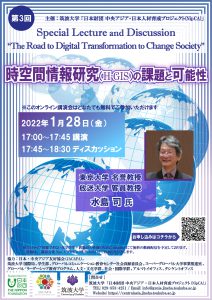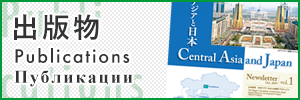On Tuesday, January 28, 2022, the NipCA project held the 3rd Special Lecture and Discussion “The Road to Digital Transformation to Change Society” series. We invited Dr. Mizushima Tsukasa, Professor Emeritus of the University of Tokyo and Visiting Professor of the Open University of Japan. Professor Mizushima delivered a lecture titled “Challenges and Possibilities of Historical-Geographical Information Systems (H-GIS),” followed by a discussion among the participants.
As a leading researcher of South Asian history in Japan, Dr. Mizushima has long conducted research on rural India and Indians in Southeast Asia. He is also the one who introduced the concept of global history to Japan. In this lecture, Dr. Mizushima talked about developing research using H-GIS (Historical Geographical Information System/Science, Space-Time Information Research).
In historical research, toponyms constitute a significant source of information about a location. However, they sometimes move or disappear due to merging, dividing rural and urban places, or changing names. GIS is a map database retrieval system with a base map, a place name retrieval system, and GIS software that integrates spatial information with statistics and other information associated with a location. It makes GIS indispensable for historical research. Dr. Mizushima advocates the construction of H (Historical)-GIS by adding the element of time to existing GIS. In this case, GIS will arrange spatial information in chronological order and accumulate data for analysis. The development of H-GIS is currently underway. It will be so intuitive and simple that “even a second grader can use it.” H-GIS is expected to collect spatial information linked to the time axis from many people and accumulate a vast volume of data.
Professor Mizushima highlighted the potential of H-GIS as it can steadily present hypotheses and verify arguments by converting many elements into spatial information and comparing them in the form of layers. Compared to Europe, where a great deal of knowledge has traditionally been accumulated, Asia is lagging. Such difference in information has directly led to the difference in research capabilities. However, Professor Mizushima gave a very stimulating lecture on how H-GIS can bridge this gap and make it possible to create cutting-edge research from Asia.
After the lecture, students and professors in history asked many questions about the advantages of applying H-GIS in their research and the system itself. This discussion deepened their knowledge about the new system and its use in research.
The following lecture in the Special Lecture and Discussion “The Road to Digital Transformation to Change Society” will be led by Dr. Abe Haraya, professor at the University of Tsukuba and researcher in the Automated Driving Research Department at Japan Automobile Research Institute (JARI). Professor Abe will give a lecture titled “Human Factors Research for the Prevention of Traffic Accidents and the Introduction of Automated Driving.”
This event will be on February 17 at 5:00 PM (Tokyo time).




